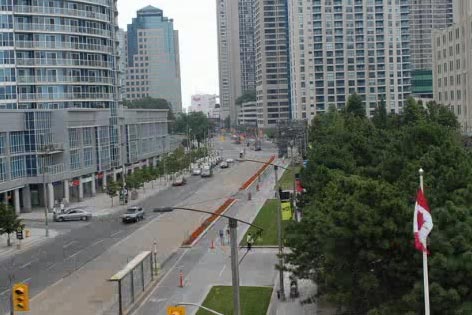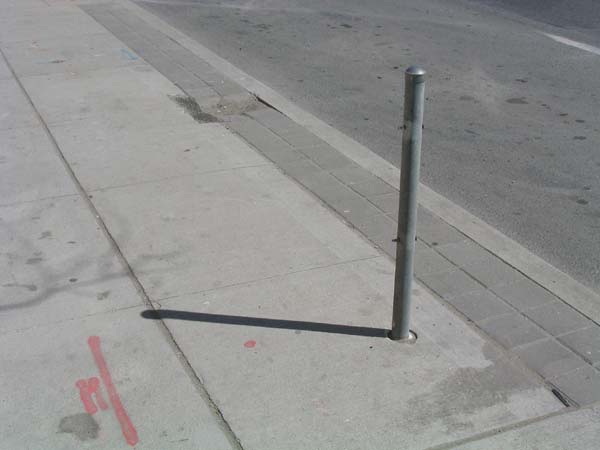I’ve been having fun over at Yellow Pages exploring just what a real downtown is all about. They’ve got a great new search feature called Proximity Search. So if you want to know what makes a more traditional downtown such a great place for people on foot, keep reading. Using Dundas and Yonge in Toronto as my centre point, I performed a search leaving the category field blank and using the smallest radius (1 km) which would give an area of 3.14 square km. The search returns 10,000 businesses. A few more searches reveal that 10,000 is the maximum the Proximity Search can return, so who knows how many more there might be.
But that’s not all – scroll down the search returns and on the left side will be a list of “related categories” which will tell you how many of each category of business falls within the search area. This shows that 902 restaurants, 1,265 lawyers, 33 hotels, 54 retail florists, 115 social and human service organisations and for some reason 72 mining companies are within 1 km of Yonge and Dundas. In case you think there might be some kind of mistake, a similar result is achieved within 1 km of Granville and Robson in Vancouver – 9,101 businesses within a very geographically restricted area – whereas again it is over 10,000 within 1 km of Ste. Catherine and St. Laurent in Montreal. The downtowns of some of our smaller cities tend to be closer to 4,000 or 5,000.
It is precisely this sheer “proximity” of such a wealth of choice and diversity of work opportunities, shopping opportunities, and services that makes downtowns such magnets – and that same concentration is what makes them reasonable places to get around without a car and logical places for the convergence of public transit. Add to these figures the large numbers of people who live within these areas and require services, and you begin to understand the vitality and bustle of the downtown – my estimate is that in the general area of Toronto around Yonge and Dundas, an area of about 3.14 square km would house about 20,000 people along with an astounding 235,000 jobs (I’ve based these statistics on data available on the City of Toronto’s Website here and here).
I bring this up in reference to our attempts at creating new “town centres” – and the constant promises of improved transit ridership through marginal increases in overall density. In order to create an efficient network of public transit, we need nodes or corridors of high density, but we also need extreme concentrations of businesses and residences like those of the downtowns listed above – places that demand transit by creating demand. We already know how to build high density suburban residential development – we’re doing it all around the GTA at densities that frequently exceed those of the City of Toronto – but these places are not seeing the transit ridership many would have hoped for – in fact, the transit modal split for the GTA is going to continue falling for many years before we succeed at inching back up – it could be 2020 before we’re back where we are now (see the Neptis reviews of Smart Growth).
With the vast size of the GTA, expecting time-efficient transit service capable of replacing the automobile without extremely dense nodes (such as a downtown) seems thoroughly naive. Yet all of our attempts to create new “town centres” so far pale in comparison to the central downtowns of a Toronto or a Vancouver. When I perform the same proximity search as above for Mississauga’s downtown (an area that includes the colossal Square One Mall) it returns 1313 businesses – for Scarborough Town Centre (coincidentally another mall) it returns 1,243.
As a comparison, I would like to present one last search to put these results in perspective – Dundas and Ossington in Toronto – a primarily residential neighbourhood of detached and semi-detached homes cut by a grid of “main street” retail about 2 km west of downtown. A 1 km proximity search on yellowpages.ca returns 3,240 businesses – more than double the number of businesses within a 1 km radius of downtown Missisauga.
This kind of extreme meshed mixed use of old inner cities is the stuff transit dreams are made of. For many, it is also the stuff urban livablility is made of – choice – the choice to walk, bike, take transit or drive – the choice of many businesses, restaurants and stores within walking distance. Despite constant rhetoric to the contrary, suburban development is not delivering on these key markers of a truly sustainable urban life and won’t be any time soon. It is hard to imagine that we will easily find a way of reproducing the amazing mix of business and homes of the inner city neighbourhood, but we can rethink the scale we are imagining new city centres because these do have the capability of reproducing the function of the traditional downtown, but only if they present the diversity, density, vitality and concentration that makes true downtowns natural nodes (of both transit and urban life) instead of imposed ones.

























